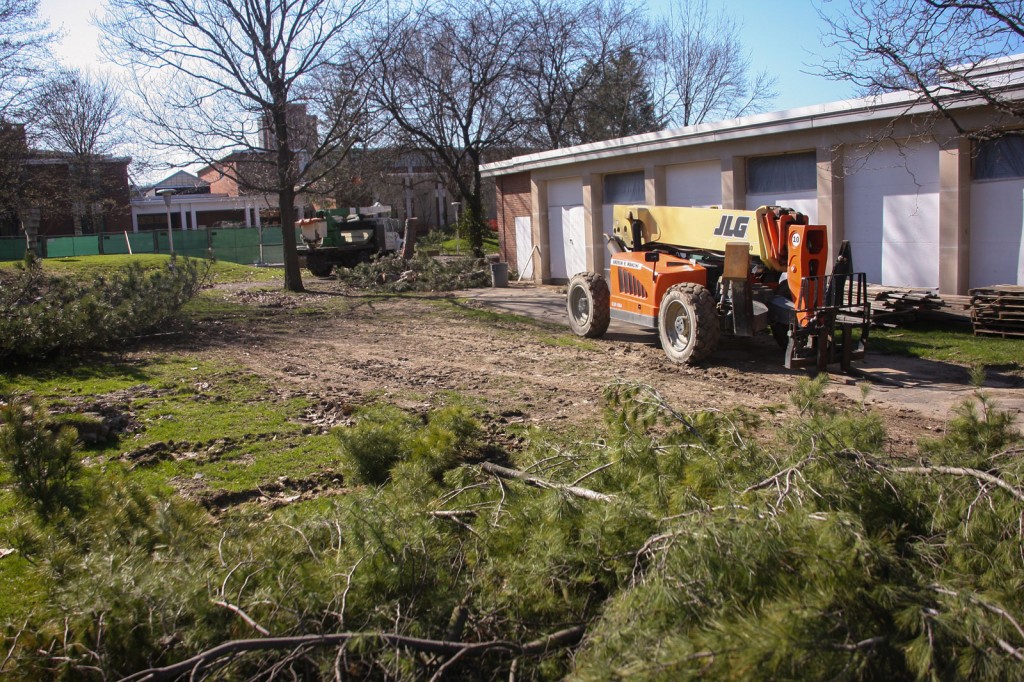Following the removal of 30 trees from the old Dickinson community earlier this week without student notification, members of the Student Association Student Assembly brought forward a piece of legislation calling for an increase in communication between students and the administration.
Workers began removing trees Monday from the area near the old Dickinson dining hall and the University Union.
Samson Widerman, Student Association executive vice president-elect, started reaching out to students once he noticed the orange X’s marked on the to-be-removed trees.
“Almost of all of the students I spoke to were unaware and alarmed to learn the tree removal took place,” Widerman said. “I didn’t meet a single student that didn’t think the University committed a serious wrong.”
Widerman wrote a piece of legislation, to be voted on at the SA meeting Monday, that calls for administration members to visit the Student Assembly and for the University to consult and notify students “well in advance” of drastic physical changes to campus.
“It’s not just an environmental issue,” Widerman said. “The way the University went about doing this was disrespectful to the opinions of students and what historically students here have really cared about.”
Karen Fennie, communications specialist for Physical Facilities, normally sends out the campus notifications of large construction projects. She said the project coordinator for the Dickinson tree removal did not notify her in time for her to send an alert to students.
“Those are the kinds of things I like to get out in front of and tell the campus ‘we are doing this.’” Fennie said. “We have done that in the past when we have tree removals that are very noticeable, because I’d rather be out in front of it than reacting like I am now.”
According to Fennie, the Dickinson tree removal will prevent structural damage to the buildings in the area.
“Some were removed because of closeness to the buildings, others because they stood where the 13,000 square foot addition will be constructed and others because they are in the way of utility re-locations that are taking place as part of/to facilitate the project,” Fennie wrote.
In addition to students, another concerned body on campus was unaware of the project before it began. The Committee for the University Environment (CUE), a committee of the Faculty Senate, typically reviews major projects that affect the University’s natural environment.
Julian Shepherd, chair of CUE and an associate professor in the biology department, said the committee had a “general discussion” last November regarding the plans for Dickinson, but never received details of landscaping or tree removal.
“We are there to advise — and that’s important, we don’t have any powers, really — but we’re there to advise the University on anything to do with environmental issues,” Shepherd said. “One of our particular purviews is looking at plans for new construction on campus, and we’re supposed to advise on that, what to plant and so forth.”
CUE policy calls for each tree removed to be replaced by “at least three new trees somewhere on campus.” Additionally, the committee recommends planting larger shade species and makes recommendations for which species should be planted on campus.
“[Big trees] sequester a lot more carbon dioxide, they create more shade, and actually, I would say that they make the University look a lot better,” Shepherd said.
The East Campus Housing Project, Shepherd said, cleared out some of those shade-bearing trees.
“I guess it’s pretty obvious they couldn’t save the trees there, but they were all the big, old trees on campus,” Shepherd said. “So what we’re gradually becoming is a campus of young trees, and I’d like to minimize that as much as possible.”
Shepherd said that a lot of the replanting has been up to CUE standards, but that the University “missed the boat” in instances like the Harpur Quad and Science I construction by failing to plant the large trees the committee recommends.
Ravi Prakriya, student representative to CUE, said the Faculty Senate committees lack centrality, which hinders communication to students.
“I’m not saying we have an apathetic student body, we have a student body that doesn’t know, and that’s not necessarily their fault,” Prakriya said. “The best way I can serve students is if I’m plugged into all the things they don’t know about.”
Prakriya cited the University’s failure to notify students of the Dickinson tree removal as an example of a disconnect between students and administrators.
“Given that this is a long-lived project — like they probably initially proposed the Dickinson stuff two or three years ago to my counterpart in CUE back then,” Prakriya said, “I’m surprised that they couldn’t get that in front of B-line.”



